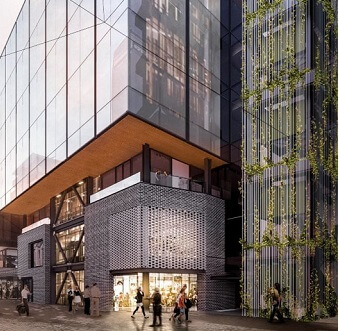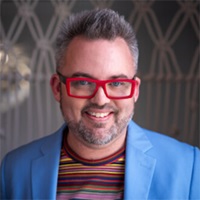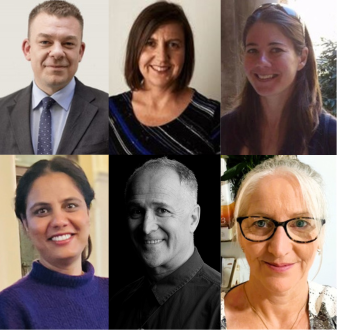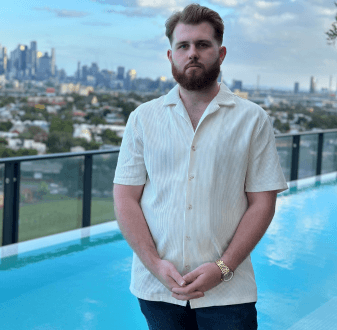Auckland’s Media Design School (MDS) has officially thrown open the doors to its new campus in the heart of the Wynyard Quarter Innovation Precinct. With a 23-year history and a reputation as New Zealand’s most awarded tertiary institution for creative and digital technology qualifications, the relocation reinforces MDS’s ongoing priority of embedding its students deeply within their chosen industry.
“Since we first opened in 1998, a connection to industry has always been a vital part of the Media Design School story,” says Darryn Melrose, General Manager, Design and Creative Technology.
“As technology speeds up and the pace of change accelerates, it’s important for students to be integrated in industry and vice versa. The new campus in the Innovation Precinct elevates and opens up our possibilities in that realm.”
Part of the Torrens Global Education network (along with Torrens University and Think Education in Australia), this next chapter of MDS reflects the network’s broader push for a global outlook with firm local roots. The precinct is home to some of New Zealand’s biggest tech players – including Datacom, IBM and GridAKL – and as the only education provider, the campus’s proximity to industry is expected to be a major drawcard for prospective students both locally and internationally.
An ethos embodied in architecture
Located in the seven-storey 10 Madden Street building, the site of the campus itself was recently described by the NZ Herald as “the most sustainable and biggest urban-regenerated neighbourhood in the country”, earning a 5 Green Star rating under the Waterfront Auckland Custom Tool.
Melrose believes the architectural and interior design of the campus lends itself to MDS’s overarching goal of connecting students with industry throughout their studies.
“It doesn’t look or feel like a normal campus – it’s not a series of lecture halls, corridors and libraries, although we do have that functionality. It’s a big, open-plan, creative space located in the middle of another big, open-plan, creative and innovative precinct,” says Melrose.
“The design of the campus encourages this idea that our students should be working in partnership with industry from day one, and that industry isn’t something you should suddenly arrive at when you graduate.”
Ruth Cooper, Country Director for the New Zealand division of Torrens Global Education adds that the campus design should be commended not only for its layout and sustainability features, but also for its connectedness to culture.
“One of the amazing things about the new campus is the way this vision is integrated into the building itself,” says Cooper, referring to the campus’s wayfinding navigational design that are steeped in Māori and Pasifika storytelling.
“As students, staff and visitors navigate each of the school’s levels within the building, they are guided by words, colours and design features symbolising Māori and Pasifika stories and providing a cultural context to every step taken on campus.”
The pick of the industry
Through partnerships with industry groups and organisations, MDS students enjoy the promise of a range of pathways into their chosen careers. These partnerships are intended to be symbiotic: the industry gains access to students and job-ready graduates, and students are ensured up-to-date knowledge and real-world experience within the relevant sector.
The high education standards and industry connections deliver world class results for students, year in, year out – with MDS students taking the top spots not only in student awards but prestigious industry awards too. In 2019, MDS student Mona Gabr took home Gold, Silver and Bronze awards at The Designers Institute of New Zealand’s Best Design Awards, and the following year received accolades in Australia’s Good Design Awards for outstanding design and innovation.
Mona’s project, titled Pick, is a prototype tag system providing assistance to people with disabilities when catching the bus on public transport. Using NFC technology, Pick allows communication between the individual and bus drivers to ensure the passenger gets on the correct bus.
“After finishing up at MDS, Mona ended up working for Datacom here in New Zealand and eventually in Australia too. It’s a great story of a capstone project not only winning awards but having real industry influence too,” says Jim Murray, Programme Coordinator of the Bachelor of Media Design.
Elsewhere, MDS offers several other partnerships to help students dive into real-world projects during their studies.
For the past few years, Bachelor of Media Design students have worked on live briefs from the Auckland Council for the annual Matariki festival – recently announced by New Zealand Prime Minister Jacinda Ardern as a public holiday, with the inaugural observance set to occur in 2022.
“Next year’s Matariki is something we’ve been working on with Panuku Development Auckland, part of Auckland Council,” says Murray, adding that students are briefed on a specific design problem then must work collaboratively on solving it.
“It might involve a motion designer, a graphic designer or an interactive designer, and they’ll work together to pitch back their concept and proposal, then work through them over several sessions. The final concepts are then presented to lecturers and industry guests.”
The outcome is not only a win for the Matariki festival but also for the students, many of whom will be experiencing real-world contact with the industry for the first time through this project.
“It’s also a win for the local community, who get to experience these works the students have made with the intent to actually effect change. Also, the students get to see their work out there in the world, as opposed to in-house projects that don’t really have any connection to the real world,” says Murray.
Also vital to MDS’s industry partnership strategy is connecting with Māori enterprise. One such example is Kiwa Digital, who last month launched their Aho Wahine project at MDS, with a ceremony hosted by the Minister for Arts, Culture and Heritage, Hon. Carmel Sepuloni. Aho Wahine is a series of bilingual apps breathing new life into the traditional stories of Aotearoa, interpreting from the point of view of the women in the stories.
“Kiwa Digital are our neighbours at the Wynyard Quarter innovation precinct, and we wouldn’t have been able to be such an integral part of the launch were it not for the new campus. We’re just thrilled to be connected with them,” adds Ruth Cooper.
Industry-standard incubator programmes
MDS Studios is the entrepreneurship initiative of Media Design School, designed to help full-time students maximise the potential of their creative ideas. At its core is the Business Incubator Programme, which gives recent graduates the unique opportunity to transform their final-year project into a commercial venture. First launched in 2015, the incubator has since helped incorporate seven companies and launch three products internationally.
“We put on an event where our third year students come together in teams to pitch their projects to a panel, which includes industry figureheads, the best projects are chosen,” explains Cooper.
“They get access to state-of-the-art technology as well as mentorship to commercialise the projects they’re working on. There’s some phenomenal work happening with the three incubator projects at the moment.”
One MDS Studios success story is Mythos Party, an online multiplayer brawler game set in a lighthearted, mythological universe where you compete for the glory of your chosen God. Now working out of MDS Studio, the Mythos Party team have partnered with Digital Natives Academy (DNA), a non-profit empowering young people wanting to enter the creative tech industry through three pou (pillars): coding, animation and eSports.
The team are now hard at work fine-tuning Mythos Party to provide DNA with an age-appropriate, multi-player eSports game targeted to younger audiences, and that can be used as an educational tool for students and schools. Once Mythos Party is released on Steam later this year, the team will begin work on a Māori and Pasifika expansion pack.
Partnerships for cultural connectedness
Be Good is one of Media Design School’s core values. These two words speak to a shared vision between MDS and Torrens University Australia – to be a private company delivering public good around the world.
At the heart of MDS’s efforts around this core value is the Māori and Pasifika Matawhānui, a four-year strategic vision geared towards elevating the voice and knowledge of Māori and Pasifika students and staff. Led by a dedicated Māori and Pasifika steering committee, the vision has three pou (pillars) of focus – students, staff and culture – and is central to Melbourne School of Design School’s approach to industry partnerships. But these partnerships don’t just occur within the MDS campus – they’re also geared around taking MDS out into the community.
One such partnership occurs at Pacific Advance Secondary School (PASS), the first Pasifika secondary school in the country, based in the Auckland suburb of Ōtāhuhu, and where MDS faculty run regular workshops for students in Years 9 to 13. Elsewhere, a more recent partnership with Manurewa High School in South Auckland sees MDS staff visiting the school once a week to deliver three-hour taster courses in creative tech.
Ruth Cooper also shares the example of a partnership project in the regional town of Murupara, 65 kilometres southeast of Rotorua and with a predominantly Māori population of less than 2,000 people.
“The local government there has developed digital hubs in a small number of regional towns – including Murupara – many of which are really underutilised. So we’re setting up a partnership where we can stream in our classes with industry-trained lecturers, and offer support on the ground as well,” says Cooper, adding that the project is being piloted in Murupara but is intended to be replicated in other small regional towns across the country.
“Ultimately, we want our Māori and Pasifika learners to feel that they have the upper hand, and that this school celebrates them, gives them opportunity, and is a culturally safe environment to learn in. We want to bring MDS to them – and the response so far has been very positive.”
Setting industry trends into the future
MDS is home to many firsts in New Zealand’s tertiary education sector. It is home to the country’s longest-running and most established 3D animation and game development programmes; in 2016 it became the first tertiary provider in New Zealand to offer a qualification with a dedicated stream for virtual reality (VR) and augmented reality (AR); and in 2019 it launched the country’s first Bachelor degrees in the ever-expanding fields of artificial intelligence (AI) and cloud computing.
In the world of games, MDS is the first tertiary institution in the southern hemisphere to offer a dedicated programme for 3D animation. It is also the first school in New Zealand to provide a specialised games course for students who aspire to be game developers.
For those aspiring game developers, MDS is the only school in the country where students can create games for the PlayStation platform. It is also the only Unity Authorised Training and Certification partner in New Zealand.
“The games industry in New Zealand is building momentum really rapidly,” says Darryn Melrose, adding that MDS was the first school in New Zealand to really realise the value of these emerging industries.
Melrose points to MDS’s partnerships with existing initiatives like Techweek and Girls in Games as key factors in ensuring the continued growth of the sector.
“Girls in Games is a really great way to reach some parents who don’t quite understand these emerging industries,” says Melrose.
“You’d be surprised how many parents think that games are just about mucking around – they often don’t understand that it’s also a viable career option with potentially really good income. These initiatives can help provide parents with enough information to support their kids in choosing games or creative tech as a study pathway. It’s really exciting.”
New beginnings for an NZ education mainstay
Through countless partnerships with prestigious schools and universities, Torrens Global Education has worked hard to develop a fresh, modern and global perspective for higher education.
“What has always set Torrens Global Education apart is our international mindset, a kind of global nous. But a global mindset without proper cultural foundations is meaningless – you can’t just be global for the sake of being global,” says Darryn Melrose.
“Whether it be Torrens University in Australia or MDS in New Zealand, we live and die by the quality of our education. MDS is just such a leader in this regard. It’s a great example of what happens when education, industry and local community come together to create a truly world-class institution.”
Learn more about our Media Design School story in the video below.




